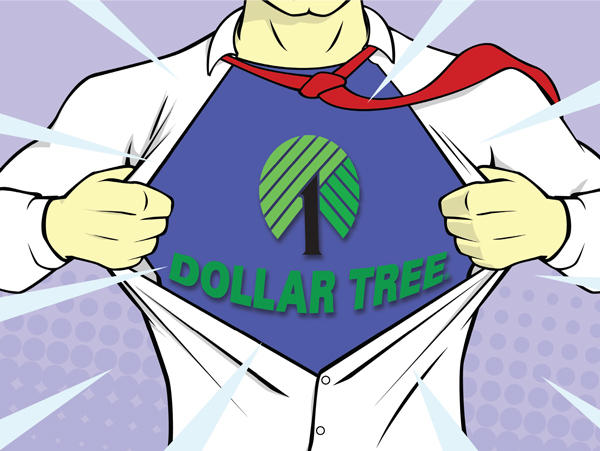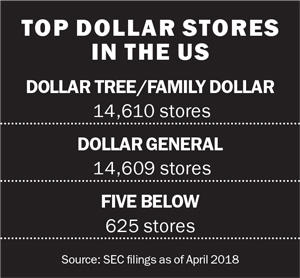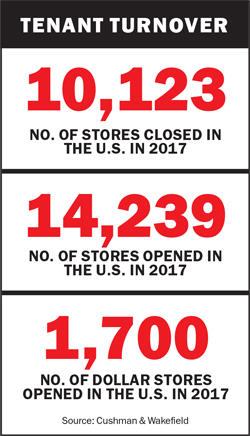
It’s been called the “e-pocalypse”: the closing of so many brick-and-mortar stores because customers would rather get what they need with a click.
But not every retailer seems to be swept up in the destruction.
Discount retailers, which sell everything from spaghetti sauce and shampoo to sweatshirts — sometimes for as little as $1 — are not turning off the lights for good, like department stores and others. They’re actually exploding in growth countrywide, experts told The Real Deal.
Unlike pricier competitors, the stores seem to be successfully fending off the challenge from online vendors specializing in cheap products: namely, Amazon.
“So far, discount stores have been e-commerce-immune,” said Garrick Brown, a vice president of the brokerage Cushman & Wakefield who studies the retail sector. “That super-low price point on the goods they offer, I don’t think it will ever make sense on the economics for Amazon to compete with them.”
The discounters also typically have deep pockets: Dollar Tree and Dollar General are publicly traded Fortune 500 companies.
Financial stability is a central consideration, given that it’s a tough landscape in which to survive. In 2017 alone, 10,123 stores went dark across the country, and more than 8,000 of those locations were part of major chains such as Radio Shack, Payless ShoeSource, Sears and Kmart, according to Cushman. Chains are expected to experience more closings as 2018 progresses, the firm predicts.
That said, 2017 also saw the opening of 14,239 stores, for a net gain of more than 4,000, Cushman’s numbers show. Many of those new arrivals were dollar stores, with 1,700 opening last year. That marks the continuation of a years-long run of expansion in the subsector: According to Cushman, a new dollar store has opened in the country at a pace of once every four and a half hours for the last four years.

When it comes to market leaders in terms of store locations, Dollar Tree, which in 2015 bought most of the stores from rival Family Dollar and operates them under that brand, is on top — though only by one. The Virginia-based company — founded in 1953, though it adopted its current name in 1993 — had 14,610 stores in the U.S. at the end of 2017, according to public filings.
Right on Dollar Tree’s heels is Tennessee-based Dollar General, which had a total of 14,609 U.S. stores in 2017, or just one location shy of Dollar Tree, filings show.
Demand for these types of stores’ products, which have increasingly included groceries, cuts across different income brackets, which helps explain their success, said Mark Kaplan, the chief operating officer of Ripco Real Estate, a New York-area brokerage that represents Dollar Tree as well Five Below, a smaller but fast-moving rival. Based in Philadelphia, Five Below, which promises nothing pricier than $5, had 625 stores nationwide as of 2017.
According to Kaplan, the appeal of dollar stores during the Great Recession was fairly obvious: Shoppers were often jobless and cash-strapped, and so were desperate for bargains. But despite an improving economy, customer numbers haven’t really dropped off since and may have actually swelled.
Even though the employment rate has increased, Kaplan explained, most of the population still considers themselves in a precarious financial spot.
To wit: The 40 percent of the population with the lowest income is grappling with high medical and food costs, he said, and the middle 40 percent is dealing with stagnant wages.
“So 80 percent of U.S. consumers can’t really buy anything discretionary and are drawn to these kinds of stores,” Kaplan said. “For people who are price-sensitive, price is the No. 1 value.”
Yet affluent shoppers seem to flock, too, said Ami Ziff, the retail director of Time Equities, a landlord that has increasingly turned to discount stores to plug holes at its 113 retail properties across the country. Time Equities’ shopping centers and malls, which are located in 23 states, were in early May leasing space to 20 Dollar Tree and Family Dollar stores.
“There was a major change in psyche during the recession,” Ziff said. “People came to expect a discount on everything.”
What they look for
Discount stores don’t usually wind up in blue-chip locations. Despite the ability to tap reserves of capital that comes with being publicly traded, many of the stores nonetheless operate with thin profit margins, which depend on keeping overhead costs — like rent — low, brokers say.
Family Dollar stores, which sell goods for $10 or less, for instance, are almost nonexistent on the wealthy Westside of Los Angeles. There was just one in Manhattan as of 2017, according to research by the Center for an Urban Future, a group that puts out an annual New York-focused report, “State of the Chains.” That store was located in Inwood, in Upper Manhattan, where commercial rents are relatively affordable.

In contrast, Family Dollar had 23 locations in the lower-cost New York borough of the Bronx, the report said, and it was in fact the eighth most common chain there. Ahead of it were Dunkin’ Donuts, Subway and McDonald’s, though it beat out Burger King, according to the report.
While upper-crust districts may be out of reach, no-frills discount stores seem to have a notable degree of flexibility, especially compared with other chains, which can have strict rules about size and location, brokers said.
Dollar Tree, for example, is as willing to rent a standalone building in a sprawling strip mall as a commercial storefront squeezed among others in a much smaller retail property, brokers and landlords said.
“We locate our stores where Middle America lives and shops” is the company’s pitch to landlords, according to Dollar Tree’s website.
The company has certainly put down roots in rural areas. Brokers said the small-town shopping districts where its stores are often found had in many cases previously been veritable ghost towns after Walmart opened nearby locations, forcing local vendors to close. Because of its modest size requirements, Dollar Tree was able to capitalize on empty storefronts in the heart of those communities, thus offering a great convenience for residents, brokers said.
Similarly, Five Below, which prefers 8,000-square-foot spaces, according to its website, will consider “a variety of urban, suburban and semi-rural markets.”
From market to market, rents paid by discount stores vary widely, according to brokers who have worked with those kinds of companies, but annual rents usually range from about $12 a square foot in rural areas to $40 a square foot in cities.
Vacancy solvers
In a way, discount stores have picked the right moment to grow. Considered highly desirable “investment-grade” tenants, they are also arriving as a rash of vacancies is plaguing everything from strip malls to luxury-focused thoroughfares across the country.
 In March, for example, Time Equities installed a Five Below at College Square Mall in Morristown, Tennessee, an enclosed 480,000-square-foot property that the company snapped up for $37 million last year from CBL Properties, a national mall owner.
In March, for example, Time Equities installed a Five Below at College Square Mall in Morristown, Tennessee, an enclosed 480,000-square-foot property that the company snapped up for $37 million last year from CBL Properties, a national mall owner.
The Five Below, which takes up about 9,000 square feet, was brought in to fill several storefronts left empty by the closure of local businesses, said Ziff, who declined to share the store’s rent but said that similar retail storefronts command about $21 per square foot annually in the region.
Other tenants at College Square include a T.J. Maxx, a discount clothing store that is part of the same corporate family as Marshalls and HomeGoods, which replaced a Sears in 2014.
Although T.J. Maxx and similar retailers also specialize in off-price merchandise, they have larger footprints — about 28,000 square feet on average — and sell clothes and furnishings at higher prices than dollar stores. Thus some brokers are loath to put them in the same category as the dollar stores of the world when analyzing impacts on retail real estate.
However, there is a common thread now that midmarket retailers are getting into the discount game. In 2016, in the face of declining sales, Aeropostale, a company focused on teen apparel like jeans and hoodies, created a brick-and-mortar discount chain called Aeropostale Factory. Its stores dot outlet malls owned by Simon Property Group.
Likewise, H&M, the already-low-cost clothing store, said this spring that it will unveil Afound, a discount chain with its own brick-and-mortar stores.
They join a marketplace that’s getting crowded with low-priced apparel. For example, the California-based Ross Dress for Less, a longtime discount clothing store, was among the fastest-growing national chains last year, according to Cushman & Wakefield. At end of 2017, it had 1,409 stores nationwide, plus 213 operating under the dd’s Discounts brand.
And paradoxically — or perhaps by design — Ross’s brick-and-mortar stores seem to be thriving by ignoring the e-tailing trend. Unlike many of its peers, Ross has shunned e-commerce: Shoppers can go to a website to look at oversized photos of shirts, sunglasses and handbags. But to buy them, they must visit an actual store.
Similarly, Five Below began selling items online only in summer 2016, and analysts say e-commerce represents a fraction of its business.
Some seem impressed with the offline-centric strategies. Avoiding e-commerce “keeps traffic flow strong, shopper frequency high and costs related to online delivery and fulfillment low,” according to a 2017 report from the firm CBRE titled “Is the Big Box Dead?”
It “validates their long-term viability both as retail brands and tenants,” the report stated. When big boxes do fail — Toys “R” Us shuttered all its stores in March, for instance — landlords are often forced to make over their cavernous spaces to allow for smaller discount stores.
Time Equities, for example, recently carved up a former Old Navy at the Colony Square Mall in Zanesville, Ohio, to make way for a T.J. Maxx, Ziff said. But that kind of slicing and dicing can be expensive, about $70 a square foot for an unenclosed shopping center, Ziff said. But getting a deep-pocketed national discount store in there could justify the outlay, he added.
A discount future?
If Amazon has not yet presented much of a threat to discount retailers, that could change, brokers said. This winter, the online juggernaut introduced a “$10 & under” feature that may appeal to discount-store shoppers.
And the sector does not seem totally immune to market forces. While 1,700 discount stores cut their ribbons in 2017, 40 also closed, according to Cushman, though that failure ratio might be normal.
“When times are good, it’s not uncommon for 5 to 10 percent of leases to expire or to not seek renewal,” Brown said.
Still, with perhaps 1,000 new discount stores planned for 2018, there may be a risk of oversupply, he added. “We will probably hit market saturation in the next year or two,” Brown added. “Sooner or later, there will be losers.”
Already, there are signs of weakness. In March, Dollar Tree announced that its Christmas sales were off, and as a result lowered its 2018 profit estimates.
But in the meantime, the stores seem to be doing their job in propping up an unsteady retail real estate market.
“Fortunately for us, they are one of the few sectors that’s growing in the face of a very, very challenging retail environment,” Ziff said.”
